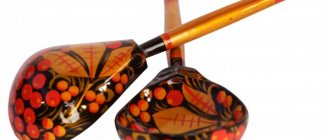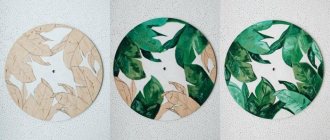How did the spoon appear?
Spoon craft is probably the most ancient of all folk crafts. After all, a spoon is the most popular household item both in a rich palace and in a peasant farmstead. When and how did the spoon appear in everyday life of modern man? The first information about a spoon comes to us from the Neolithic era, when this object was made of clay and had a shape different from what we are used to today. In ancient times, spoons were made of bone, horn, and metal.
But already in Europe, the spoon gained popularity as a wooden piece of cutlery. In Rus', the spoon appeared under the Kiev prince Vladimir.
Wooden dishes were the most popular in Rus'. If bowls and cups could still be made of clay, then a spoon is certainly most conveniently made of wood.
The first mention of Russian spoons is found in The Tale of Bygone Years, where a feast at Prince Vladimir is described. This feast is famous for the fact that the warriors were indignant when they began to be treated not from silver spoons, but from wooden ones.
The prince immediately ordered silver ones to be forged, the legend further reports. However, the wooden spoon existed in Rus' for a long time, despite the fact that the rapid development of metallurgy led to the displacement of wooden objects from everyday use.
The most famous center for the production of wooden spoons since the 18th century. became Semyonov, which was then a small village.
The birth of a spoon
Spoon fishing was widespread in the Vyatka, Arkhangelsk, and Orenburg provinces. It achieved especially widespread development in Nizhny Novgorod. In more than 130 villages of Semenovsky district they were engaged in spoon making on an industrial basis.
In Nizhny Novgorod, spoons have long been skillfully cut. But they became truly popular thanks to a unique technology - Khokhloma painting. Such spoons were not afraid of either water or hot water and served for a very long time.
Semyonovsky craftsmen made spoons “so attractive and dexterous,” writes the modern storyteller S. V. Afonshin, “that people slurped and sipped peas and jelly without butter or seasoning.”
Lozhkarny market in Semyonov. Beginning of the 20th century.
The district had more than 8,000 spoon makers, who produced up to 150 million spoons per year, which were distributed throughout Russia.
Basically, spoon making developed in areas rich in forests, but where agriculture was poorly developed. However, spoon-making was mostly done in the cold season, when there was no field work.
Caring for wooden products
If you have cooperage products in your home, then you should adhere to certain rules for storing and using wooden utensils:
- It cannot be washed in the dishwasher as there is a risk of damaging the surface.
- Due to the sensitivity of wood to moisture, it is advisable to store dishes in dry places to avoid mold. Also be sure to dry and wipe the product after use.
- To eliminate unpleasant odors and for disinfection purposes, you can wipe with an alcohol solution.
- As time passes, cooper's ware darkens. In order to restore its original color, it is recommended to wipe the surface with hydrogen peroxide.
By adhering to these simple rules, you will extend the life of wooden utensils.
Who made the spoons
The whole family was engaged in this business. Everyone had a job they could do. The men carved and cut. Young apprentices were engaged in preparations called baklushi.
The apprentices were usually boys 7-10 years old, their production rate was 70-100 pieces per day.
Women oiled, primed and painted.
A cleaver, he was usually a teenager of 10-15 years old. Using an adze, he had to hollow out up to 100 pieces. in a day.
A curler worked on a special lathe. He turned the handles of spoons. Compared to the baklushnik making baklushki, its productivity was much higher.
There was also a spoon-maker who cut out the spoon itself, the part of it that is eaten.
Baklusha - a blank for a spoon Tesla - a tool Kokovka - a knob at the end of a spoon
Traditionally, a spoon was hewn (that is, hewn) out of wood, and the tools used were an axe, a knife, and special chisels. The shape of the spoon depended on local traditions and could look like a small ladle or be almost flat. When the master got to work, the smell of birch sap and fresh wood shavings hovered around.
Stages of emergence of a spoon from a wooden block
Materials and shape
A spoon can be wooden, metal, plastic, and can combine several types of materials at the same time.
Made from any material. The spoon consists of three parts:
- A scoop is a rounded, curved part of an object that is used to scoop up food.
- Holder - the part that is held by.
- A jumper is a connection between two specified parts.
BUCKLE
This is the initial blank for the future spoon. That is, a piece of split log is shaped. At one end it remains wide, and then narrows, cutting off half of its thickness.
First, it was necessary to trim a wooden block to form the frame of a spoon. Then use a knife to process and round the workpiece, giving it the lines of the future tableware. And then the cutters were used, with which the desired recess was selected. Before painting, the spoon was dried so that the paint adhered well to the surface. But then came the miracle.
Production
The production of food dyes and varnishes is a complex technological process. Depending on the materials used - organic and inorganic - the technology is different. It is mainly based on mixing synthetic dyes consisting of water-soluble components with the addition of aluminum ions.
Initially, a dispersing mixture is prepared, then the semi-finished products are ground with pigments (synthetic or natural organic oils) to obtain the base color and its shades. Subsequently, the pigment paste is mixed with water-dispersed components, then distributed according to shade and properties, and poured into containers for sale to the consumer.
ADZE
A type of chisel mounted on a handle, like an ax, with a semicircular tip. The metal tip is cut with the “back of the head” of the wide rounded end into the recess of a cut from a log, that is, a prepared buckthorn. They rubbed it with chalk to prevent it from slipping.
They especially loved those spoons that were given as gifts. They were painted with fabulous flowers and herbs. The shine of gold and cinnabar on them was perceived as a jewel and was associated with royal luxury.
Blanks for spoons
Such spoons were used for holidays, but on weekdays they continued to use unpainted spoons made of plain wood.
Semenov's spoons dispersed in all directions of Russia. Buyers even traded them abroad - in distant Persia. A special order for wooden spoons for soldiers of the tsarist army was also traditionally fulfilled by Nizhny Novgorod residents.
It is known that in the Semenovsky district at the beginning of the twentieth century, an average of 100 million spoons were produced per year, and in 1910 a record number was reached - 170 million pieces.
Coloring of spoons, Semyonov. Nizhny Novgorod province according to the research of the provincial zemstvo, 1896.
Spoon products were produced by thousands of artisanal peasants living in the city itself and in the surrounding villages. Each had their own specialization: spoon-carvers, dyers who painted “linen” (hollowed or machine-turned utensils), and varnishers, those who coated painted utensils with varnish.
The painting of wooden spoons had its own roots, which tied it to a particular area. From the drawing it was possible to immediately determine the homeland of the product. But whatever it was - curls or diamonds, meanders or loops, ovals, circles or dots, all this was collected into a single picture of nature, its beginning, the triumph of fertility and happiness.
Each spoon maker had his own painting technique, but local customs and traditions always served as a source of inspiration. The master selected bright, expressive colors - sunny yellow, honey, emerald green, etc. And so that the newly applied drawing is not eaten along with the stew, a spoonful of oil is added. Calcined vegetable oil was used for this. And so, an almost weightless painted spoon with an elegant oval-shaped scoop and a comfortable rounded handle (holder) turned into a real beauty, dressed in a golden outfit. This is how the spoon appeared - the main cutlery of all peoples and classes without exception.
Souvenirs
Like many other things, nowadays dishes are often used as souvenirs. Spoons and plates can be covered with traditional paintings or intricate carvings, which often deteriorate with frequent use in everyday life. To give durability to the design, painted souvenirs are coated with varnish. However, such products are not recommended for cooking or eating food. Their function is completely different - they are exclusively souvenirs and decorative items.
Spoons as a musical instrument
Wooden spoons are used in the Slavic tradition as a musical instrument. The game set ranges from 3 to 5 spoons, sometimes of different sizes. The sound is produced by striking the back sides of the scoops against each other. The timbre of the sound depends on the method of sound production.
Typically, one performer uses three spoons, two of which are placed between the fingers of the left hand, and the third is taken in the right. The blows are made with the third spoon, two at a time in the left hand. Usually, for convenience, blows are made on the hand or knee. Sometimes bells are hung from the spoons.
Wood for utensils
Many people are interested in what kind of wood wooden utensils are made from. It should be noted that different types are suitable:
- for making glasses, mugs, shot glasses, it is better to use ash, hornbeam, oak and linden;
- for barrels, linden and oak will be relevant;
- Linden and aspen are suitable for spoons, and only the first type of wood for plates.
The most resistant to temperature influences are maple, cedar, bamboo, rowan and linden. However, in addition to the technical and operational properties, it is necessary to take into account the medicinal characteristics of wood. For example, oak has a beneficial effect on teeth, rowan ensures good blood circulation, and alder has calming properties. It should be noted that daily contact with such cooperage utensils will give a positive result.
Varieties of Russian spoons
Spoons in the museum at the factory in Semenov
Every spoon in Rus' had its own purpose and name.
- Liar - a spoon for distributing holy communion with a cross on the handle (that’s what the ancient Russians called any spoon). At the end of the handle of the Old Believer spoon for communion, a double finger was cut out.
- Mezheumok is a simple Russian wide spoon of medium size. This word denoted not only a spoon, but in general everything that was something in between, neither here nor there, did not belong to either one or the other). An expert in folk life, S.V. Maksimov, described the popularity of the products of Nizhny Novgorod craftsmen this way: “They make... the “mezheumok” spoon, which all Orthodox Rus' uses to break out thick porridge from pots and slurp cabbage soup without burning their lips.”
- Butyrka is a Burlatka spoon. The name, apparently, comes from the word “butyrit” - turn over, stir, mix. It is as wide as a mezheumok, but thicker and rougher. She was considered the largest. Barge haulers wore it behind a hat ribbon on their forehead instead of a cockade, as a kind of insignia, a “sign”.
- A basque spoon, or bosk spoon, is long and blunt-nosed. There is also a semi-basque - a little rounder (the word “basque” meant: beautiful, red, prominent, decorated).
- Any sharp-nosed spoon was called nosed. Isn’t that what the saying is about: “The spoon is narrow, it carries three pieces at a time: you need to spread it out so that it carries six at a time!”
- They also made folding spoons in the Nizhny Novgorod province - they were the most expensive, as well as dozen, or tea, mustard, cream, caviar and others.








